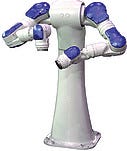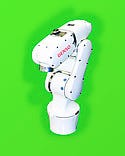Focus on Equipment: Robots
April 14, 2010
Dual-Arm Robot Features 'Human-Like' Flexibility of Movement
Click to enlarge |
Suited for use in medical device manufacturing, a series of dual-arm robots can carry out a variety of assembly, handling, kitting, and packaging operations that formerly could only be performed by humans, according to its manufacturer. Engineered with 15 axes of motion, the SDA-series robots are designed so that both arms can collaborate on a single task. Furthermore, using the dual independent arms can reduce the need for custom fixturing and allows for simpler, less expensive end-of-arm tooling, the company states. Capable of multitasking, the robots can hold a part with one arm while performing operations on the part with the other arm. They can also transfer a part from one arm to the other without setting it down. Features of the SDA10D model include a 10-kg payload per arm, a 720-mm horizontal reach, and a 1440-mm vertical reach per arm. The SDA20D robot has a 20-kg payload per arm, a 910-mm horizontal reach, and an 1820-mm vertical reach per arm.
Motoman Inc.
West Carrollton, OH
www.motoman.com
Portable Six-Axis Robot Automates Assembly Tasks
Click to enlarge |
Available in a four- or six-axis model, an intelligent, parallel-link robot accommodates payloads up to 6 kg and has the largest work envelope of any robot in its class, according to its manufacturer. Introduced as a larger version of the M-1iA product, the lightweight, portable M-3iA robot is designed to maximize speed and flexibility for complex and simple assembly operations, including for medical device assembly. Optimized for complex assembly tasks, the six-axis model features a three-axis wrist that provides flexibility to pick up and insert parts at simple or compound angles and to twist parts into place. The four-axis model, which has a single-axis wrist, is suitable for simple assembly and high-speed picking operations. It offers speeds up to 4000° per second. The robot's R-30iA controller is equipped with intelligent functions such as iRvision, force sensing, a robot link, and a collision guard.
Fanuc Robotics America Inc.
Rochester Hills, MI
www.fanucrobotics.com
Aseptic Robots Offer Class 100 Cleanroom Performance
Click to enlarge |
A series of six-axis articulated, aseptic robots provides Class 100 cleanroom performance from a compact, 200-mm-diam footprint. The VP-G2-series robots feature a payload capacity of 2 kg, repeatability of ±0.02 mm, and a standard cycle time of 0.99 seconds. Energy efficient, each of the robot's motors uses 80 W maximum of power, while all of them use a combined maximum of 300 W. Capabilities include assembly, dispensing, inspection, machine tending, material handling, packaging, and test handling for a variety of industries, including medical device manufacturing. Suitable for applications in which biocontamination control is required, the units can be safely cleaned with hydrogen peroxide.
Denso Robotics
Long Beach, CA
www.densorobotics.com
SCARA Robots Have a Curved Arm to Maximize Work Envelope
Click to enlarge |
In order to maximize work envelope usage, a series of robots is offered with a 350-mm curved arm option that matches the motion range exhibited by larger, 400-mm class SCARA robots. An expansion of the company's G-series family of robots, the compact G3 SCARA robots are available in 30 different models with reaches of 250, 300, or 350 mm. Providing high performance and reliability, they also offer best-in-class cycle times, precision, and motion range, according to their manufacturer. The Micro PowerDrive RC180 controller, which comes standard, features the company's RC+ Controls software and such integrated options as vision guidance, .Net support, Profibus, DeviceNet, and Ethernet/IP. Suitable for medical device assembly, the robots can be supplied in Class 10 cleanroom ESD-compliant versions.
Epson Robots
Carson, CA
www.robots.epson.com
Robotic Dispensing Machine Allows for On-the-Fly Adjustment
Click to enlarge |
Addressing the potential need to compensate for a material's changing viscosity, a robotic dispenser enables on-the-fly adjustments to the pressure in the syringe or tank. This capability can be useful if dispensed epoxies have limited life and thicken over time. Multiple pressure files can exist in the system at once, each with its own unique properties and values for a given application. They can also be uploaded, modified, and saved. Upon uploading a file to the system, the machine counts down using its battery-powered clock, which ensures that the pressure files are accurate despite power-down conditions. Then, once the maximum time has expired, the system prompts the operator to replace the material and press start to reset.
Dispense Works Inc.
McHenry, IL
www.dispenseworks.com
About the Author(s)
You May Also Like






